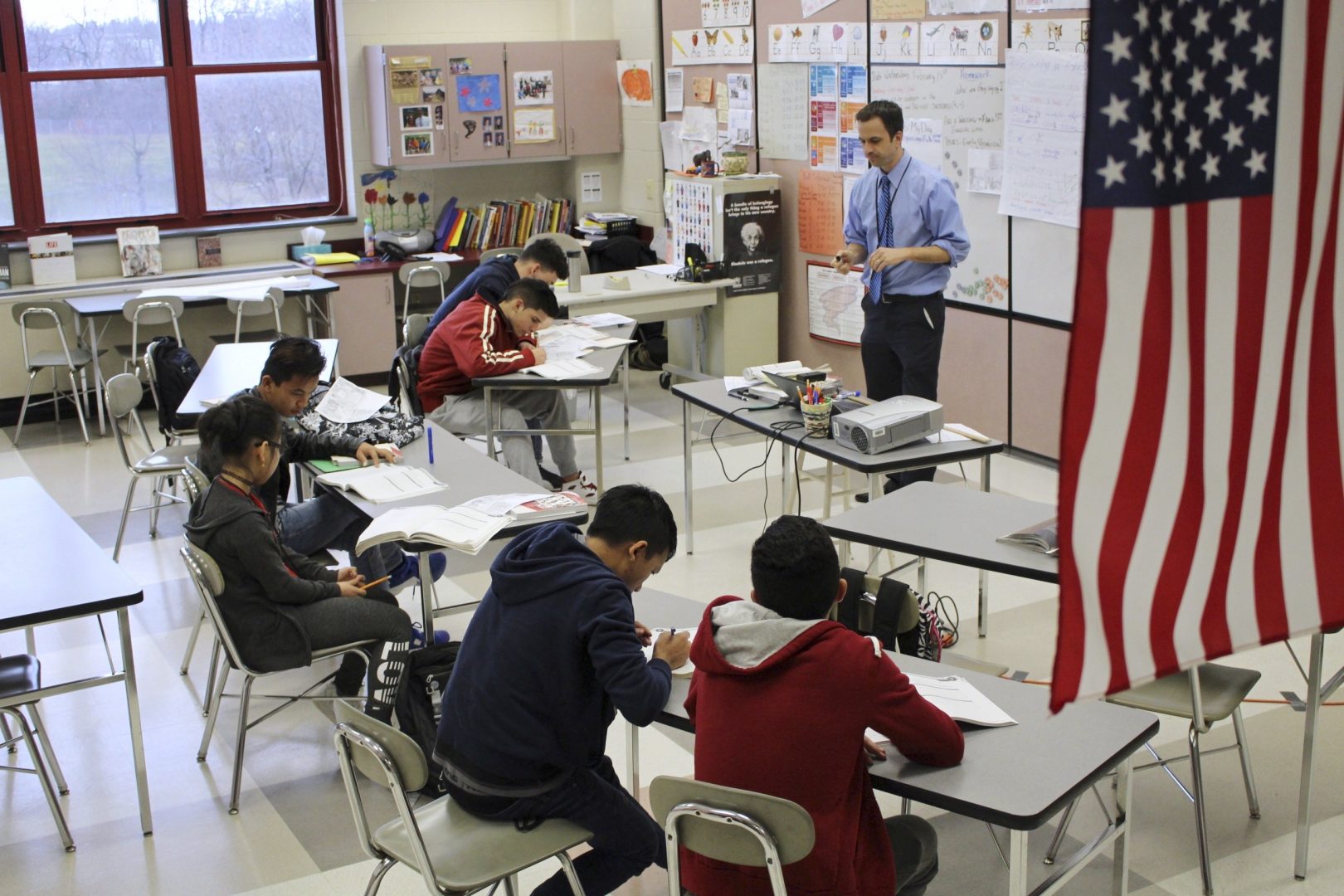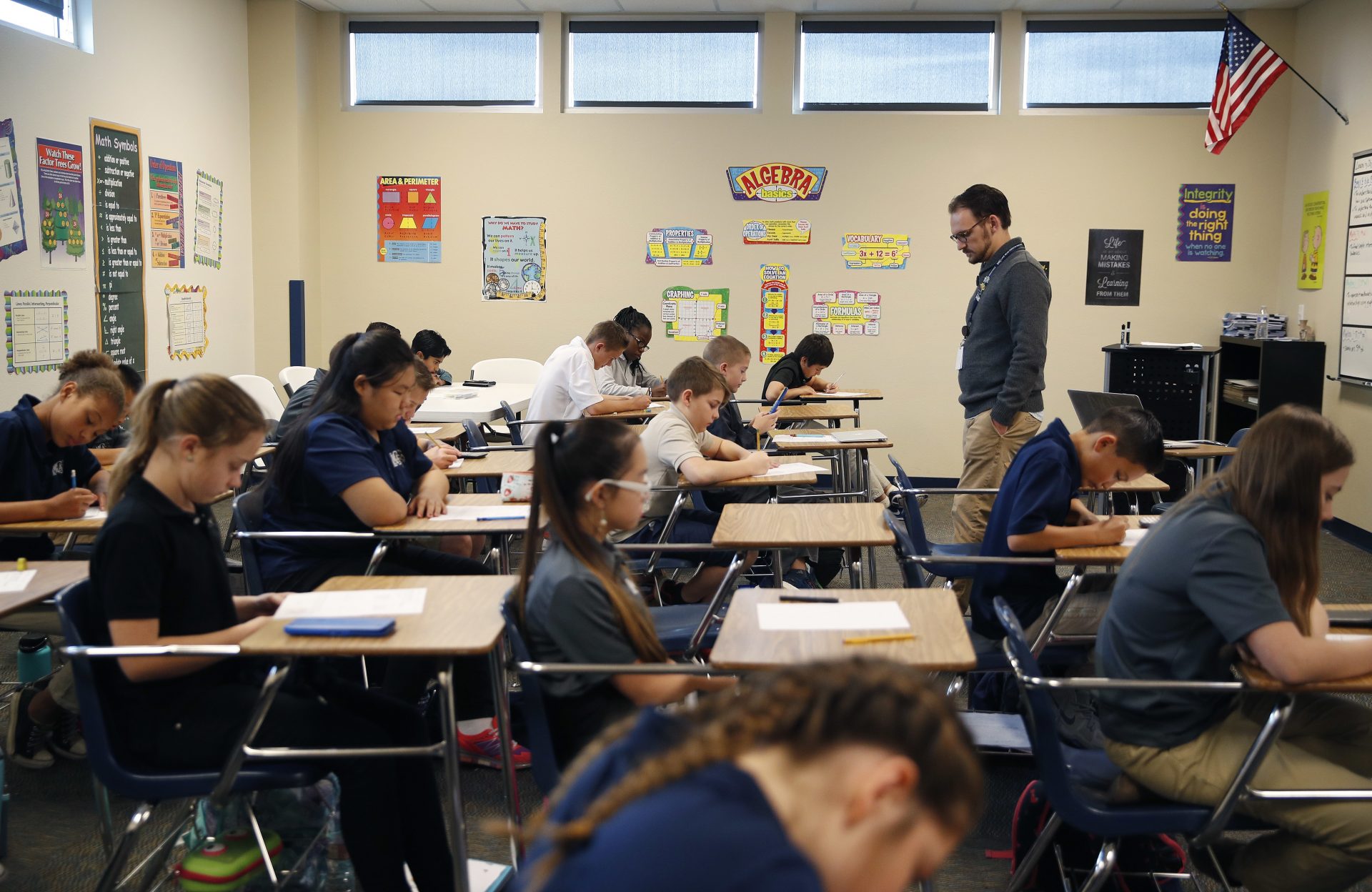
FILE PHOTO: In this Feb. 15, 2017, photo, Eric Hoover teaches his class of immigrant and refugee students at McCaskey High School in Lancaster, Pa.
Michael Rubinkam / The Associated Press

FILE PHOTO: In this Feb. 15, 2017, photo, Eric Hoover teaches his class of immigrant and refugee students at McCaskey High School in Lancaster, Pa.
Michael Rubinkam / The Associated Press

Michael Rubinkam / The Associated Press
FILE PHOTO: In this Feb. 15, 2017, photo, Eric Hoover teaches his class of immigrant and refugee students at McCaskey High School in Lancaster, Pa.
(Harrisburg) — Much like their students, public school teachers are evaluated for their performance. But student test scores may soon play a smaller role in how teachers are graded.
The state Senate is poised to vote as soon as Monday on legislation that will de-emphasize student test performance in evaluating public school teachers and principals.
Instead, the bill would increase the weight classroom observations carry in those job performance reviews to 70 percent, up from the current 50 percent. The measure would also apply a factor for student poverty level – in addition to student performance measures – in the remaining 30 percent.
Sen. Ryan Aument, R-Lancaster County, who is sponsoring the bill, said he thinks this change will help drive up student performance by moving away from the teaching to the test mentality.
“I think it will ensure greater creativity and innovation for teachers to do best what they do in the classroom – to creatively instruct,” he said.
This proposed evaluation system could become part of the overall state budget package that the General Assembly is looking to send to Gov. Tom Wolf later this week. If not, Aument and Rep. Jesse Topper, R-Bedford County, who chairs a House Subcommittee on Basic Education, say they will push for its consideration in the fall.
Wolf spokesman J.J. Abbott signaled the governor is interested in the direction this proposal heads.
“Governor Wolf believes teachers should be evaluated in a comprehensive way, including taking into consideration the impact of poverty on student academic performance,” he said. “The administration continues to monitor the bill and engage in conversations with the Legislature and stakeholders regarding the changes.”
Aument’s bill as well as an identical measure that Topper introduced in the House call for schools to begin using the new evaluation system in 2021-22.
Legislation passed in 2017 that ended seniority-based teacher layoffs in Pennsylvania and tied those decisions to educators’ job performance evaluation. That law helped to spur teacher and administrator interest groups to push for adjusting factors considered in evaluating their performance.
“It certainly motivated all the stakeholder groups to make sure this evaluation system was truly what we needed it to be and was as accurate as it could be and allow as much local flexibility as we could allow because it is much more high stakes now,” Topper said.

John Locher / AP Photo
In this Nov. 16, 2017, photo, students take a quiz in Michael Briggs’ seventh grade algebra class at Lake Mead Christian Academy in Henderson, Nev.
The current system places equal weight on classroom observation with more objective measures, such as promotion and attendance rates, student standardized test scores, and school building-wide student performance measures. The current system replaced a decades-old model that relied solely on subjective classroom observations.
But a concern arose from the mixing of building-wide measures with those of individual educators resulting in highly effective teachers in a low-performing school ending up with the same satisfactory rating, instead of a distinguished rating. At the same time, a less effective educator in a high-performing school was rated satisfactory, instead of “needs improvement” or “unsatisfactory.”
“It ended up skewing things more to the middle for everybody so you had fewer higher performing teachers and fewer unsatisfactory teachers,” said Mark DiRocco, executive director of the Pennsylvania Association of School Administrators. “That was not the intention of the Legislature when they put it in place but once it was actually put into practice, that’s what happened.”
That had the effect of making it more difficult for districts to remove ineffective educators, which could happen if they received two consecutive unsatisfactory ratings. Additionally, those who received an unsatisfactory rating under the new furlough law would now be the first to go.
The Pennsylvania State Education Association as well as the school administrators’ group supports the legislation.
“The direct observation of educators by trained professionals is the best form of evaluation, providing clear, fair and timely feedback,” said PSEA President Rich Askey. “By placing greater emphasis on direct observation, the bills set the state for educators to receive meaningful feedback and targeted assistance that will help them improve their professional practice.”
PSEA also applauds the inclusion of student poverty levels factoring into evaluations. The teachers union calls it an important first step to acknowledging the relationship of poverty and student achievement, although some view this as establishing lower expectations in law for poor students.
“Poverty affects students well beyond the classroom, often hampering their health and well-being, language development, and access to books and learning opportunities,” Askey said. “Students living in poverty often score lower on standardized tests.”

Matt Rourke/The Associated Press
FILE PHOTO: Students in Robbi Giuliano’s fifth grade class sit on yoga balls as they complete their assignments at Westtown-Thornbury Elementary School in West Chester.
This move away from heavy emphasis on student test scores falls in line with a change the General Assembly made last year to provide alternative pathways for students to be eligible to graduate high school beyond passing the state’s Keystone Exams, Aument said.
“There’s a role for standardized assessments but I think it is clear the pendulum has swung too far and we need to continue to revisit these policy decisions we make and make adjustments,” Aument said.
Topper agreed: “We all know test scores need to be part of what we do in terms of standardized testing but they do not need to be as large of a part.”
PennLive and The Patriot-News are partners with PA Post.

A collection of interviews, photos, and music videos, featuring local musicians who have stopped by the WITF performance studio to share a little discussion and sound. Produced by WITF’s Joe Ulrich.
The days of journalism’s one-way street of simply producing stories for the public have long been over. Now, it’s time to find better ways to interact with you and ensure we meet your high standards of what a credible media organization should be.